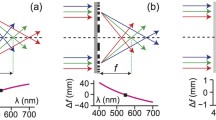Abstract
Circular grooves are frequently cut in dielectric lenses and windows to form antireflection layers. These induce a phase difference between polarisation components, with consequent loss of power into cross-polarisation and a phase error similar to astigmatism. Expressions derived for these losses show that the losses are generally small compared to the insertion losses of an unmatched surface. For several consecutive surfaces the effects may be quite significant.
Similar content being viewed by others
References
M. Born and E. Wolf:Principles of Optics, 6th ed., Oxford: Pergamon, 1980.
R. Bräuer and O. Bryngdahl, “Design of antireflection gratings with approximate and rigorous methods,”Appl. Opt., vol. 33, no. 34, pp. 7875–7882, Dec. 1994.
J. Ruze: “Antenna tolerance theory—A Review,”Proc. IEEE, Vol. 54, pp. 633–640, April 1966.
Author information
Authors and Affiliations
Rights and permissions
About this article
Cite this article
Lamb, J.W. Cross-polarisation and astigmatism in matching grooves. Int J Infrared Milli Waves 17, 2159–2165 (1996). https://doi.org/10.1007/BF02069491
Received:
Issue Date:
DOI: https://doi.org/10.1007/BF02069491




